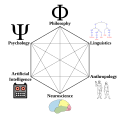The denotational semantics of the Actor model is the subject of denotational domain theory for Actors. The historical development of this subject is recounted...
25 KB (3,346 words) - 16:31, 9 November 2022
science, denotational semantics (initially known as mathematical semantics or Scott–Strachey semantics) is an approach of formalizing the meanings of programming...
32 KB (3,784 words) - 17:17, 20 November 2024
metalanguage. For example, denotational semantics of functional languages often translate the language into domain theory. Denotational semantic descriptions...
18 KB (1,671 words) - 03:37, 10 May 2025
semantics Laws for actor systems Denotational semantics Transition semantics There are also formalisms that are not fully faithful to the actor model...
81 KB (7,145 words) - 15:49, 22 June 2025
History of denotational semantics. Actor model and process calculi history History of denotational semantics Actor model middle history Actor model later...
23 KB (2,777 words) - 13:34, 7 June 2025
In computer science, model checking or property checking is a method for checking whether a finite-state model of a system meets a given specification...
25 KB (2,788 words) - 21:41, 19 June 2025
a denotational model of Actors (see denotational semantics). Clinger [1981] used the Actor event model described above to construct a denotational model...
13 KB (1,545 words) - 00:52, 10 May 2025
Power domains (redirect from History of power domains)
In denotational semantics and domain theory, power domains are domains of nondeterministic and concurrent computations. The idea of power domains for functions...
9 KB (1,165 words) - 20:29, 6 May 2025
failures/divergences model. Semantic mappings from process expressions to each of these three models provide the denotational semantics for CSP. Denotational semantics allows...
45 KB (6,476 words) - 15:14, 30 June 2025
Indeterminacy in concurrent computation (redirect from Actor model, mathematical logic, and physics)
models of concurrency did not determine particular concurrent computations as follows: The Actor model makes use of arbitration (often in the form of...
10 KB (1,318 words) - 19:27, 18 August 2024
Thati History of denotational semantics History of the Actor model Carl Hewitt, Peter Bishop and Richard Steiger. A Universal Modular Actor Formalism for...
18 KB (2,420 words) - 00:55, 29 July 2023
dissertation, Will Clinger developed the first denotational model of Actor systems. See denotational semantics of the Actor model. Carl Hewitt; Peter Bishop and...
8 KB (1,043 words) - 14:37, 27 January 2022
Programming language theory (redirect from Theory of programming languages)
of a computer program are denotational semantics, operational semantics and axiomatic semantics. Type theory is the study of type systems; which are "a...
15 KB (1,613 words) - 05:07, 21 April 2025
William Clinger (computer scientist) (category Year of birth missing (living people))
(MIT) under the supervision of Carl Hewitt. His doctoral research revolved around defining a denotational semantics for the actor model of concurrent computing...
6 KB (362 words) - 10:25, 3 January 2024
considered as a branch of order theory. The field has major applications in computer science, where it is used to specify denotational semantics, especially for...
19 KB (2,689 words) - 14:25, 7 May 2025
Concurrency (computer science) (section Models)
"tagged-signal" model can be used to provide a common framework for defining the denotational semantics of a variety of different models of concurrency,...
14 KB (1,420 words) - 04:19, 10 April 2025
published the first satisfactory mathematical denotational theory of the Actor model using domain theory in his dissertation in 1981. His semantics contrasted...
25 KB (3,252 words) - 20:48, 19 June 2025
mathematical theories of concurrency such as various process calculi, the actor model, or Petri nets. A more detailed account of concurrency semantics is given here:...
625 bytes (56 words) - 08:30, 28 June 2024
Unbounded nondeterminism (category Denotational semantics)
abstract models rather than practical systems, became significant in developing mathematical descriptions of such systems (denotational semantics) and later...
24 KB (2,718 words) - 20:55, 11 March 2025
continuous semantics, aiming to abstract over many operational details that are not important to the meaning of a program. The key properties of this formulation...
12 KB (1,285 words) - 21:31, 5 October 2024
theory and denotational model. Investigations began into the basic power of the Actor model. Carl Hewitt [1985] argued that because of the use of Arbiters...
12 KB (1,443 words) - 12:31, 27 January 2021
Look up reification in Wiktionary, the free dictionary. Denotational semantics Formal semantics of programming languages Meta-circular evaluator Metamodeling...
18 KB (2,270 words) - 10:54, 29 April 2025
also used in models of computation including denotational semantics, the actor model, process calculi, and lambda calculus. These models rely on programmers...
27 KB (3,043 words) - 15:10, 27 June 2025
Cognitive science (redirect from Computational modeling of cognitive processes)
development of behavioral finance, part of economics. It has also given rise to a new theory of the philosophy of mathematics (related to denotational mathematics)...
74 KB (8,629 words) - 22:35, 23 May 2025
Functional programming (redirect from Comparison of imperative programming and functional programming)
The technical difference is in the denotational semantics of expressions containing failing or divergent computations. Under strict evaluation, the evaluation...
87 KB (8,696 words) - 16:44, 4 June 2025
member, advanced lambda calculus to model programming languages (aided functional programming), denotational semantics Tom Lane – Independent JPEG Group...
55 KB (5,250 words) - 22:02, 24 June 2025
language), father of Denotational semantics Bjarne Stroustrup, the 2015 AITO Dahl–Nygaard Prize for the design, implementation, and evolution of C++ and IEEE...
58 KB (5,835 words) - 21:51, 25 May 2025



